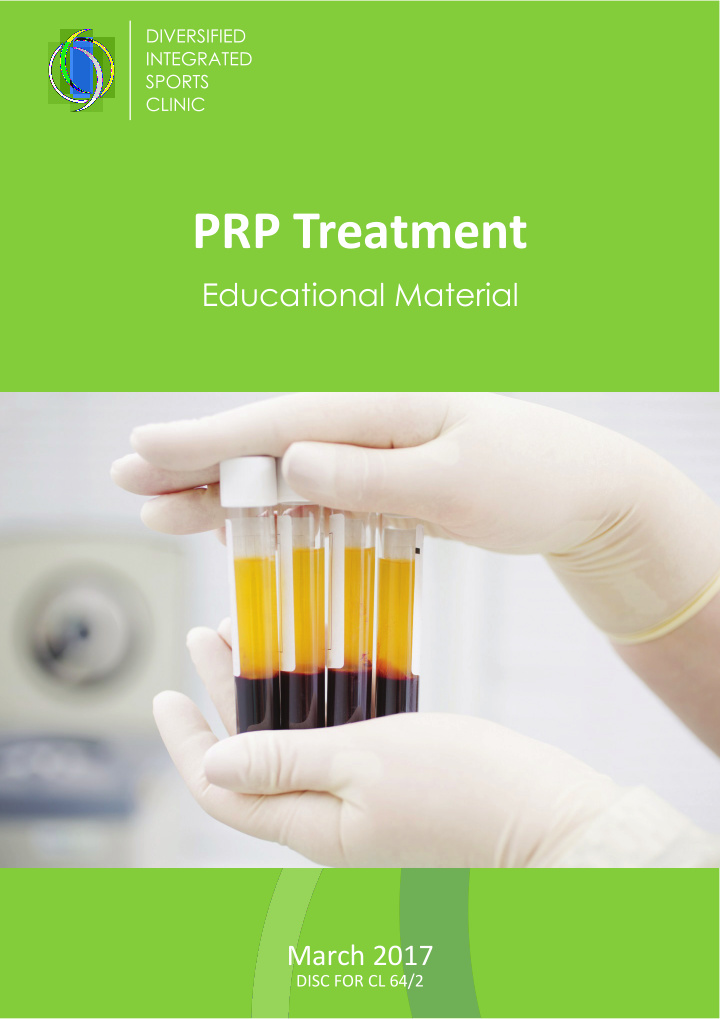



PRP Treatment Educational Material March 2017 DISC FOR CL 64/2
What is PRP ? ”Platelet-Rich Plasma Therapy speeds healing of musculoskeletal Injuries” Platelet-rich plasma (PRP) therapy, a treatment for aiding the regeneratjon of ligament and tendon injuries, helps to shorten rehabilitatjon tjme and ofuen eliminates the need for surgery. Platelet-rich plasma therapy is part of a relatjvely new fjeld of medicine known as orthobiologics that includes the use of stem cells and emphasizes employing the latest technologies along with the body’s natural ability to heal itself. “One of our major goals is to make healing tjme faster for patjents with sofu tjssue injuries,” says Christopher S. Ahmad, MD, Director, Center for Pediatric and Adolescent Sports Medicine at NewYork-Presbyterian Morgan Stanley Children’s Hospital. “For example, a patjent undergoing elbow ligament reconstructjve surgery, commonly referred to as Tommy John surgery, may take a year to recover. That’s a long tjme. Recovery tjme for anterior cruciate ligament [ACL] surgery is approximately six months. So while we are very good at performing surgery to correct these injuries, we’re now acceleratjng the healing by biologic manipulatjon. That’s where platelet- rich plasma comes in.” What is Platelet-Rich Plasma? Blood is made of red blood cells, white blood cells, plasma, and platelets. Platelet-rich plasma (PRP) is the name given to blood plasma with a high concentratjon of platelets that contains huge doses of bioactjve proteins, such as growth factors, that are critjcal in the repair and regeneratjon of tjssues. In order to extract these platelets, a small amount of blood is drawn from the patjent and it immediately undergoes centrifugatjon, a process in which mixtures are separated using centripetal force. This process separates out red blood cells, which carry oxygen, and the platelet and the plasma. The platelets with the plasma have all of the healing agents. Once the separatjon is done, the platelet-rich plasma is extracted and can then be injected back into the patjent’s injured area. It is their own platelet-rich plasma -- it isn’t taken from another person or derived in a laboratory. Growth factors can dramatjcally enhance tjssue recovery and the special proteins also initjate new blood vessel formatjon, bone regeneratjon and healing, connectjve tjssue repair, and wound healing. There is litule chance for rejectjon because the components used for treatment are extracted from a person’s own body. This makes the procedure entjrely safe. The PRP injectjon also carries less chance for infectjon than an incision, with a considerably shorter recovery tjme than afuer surgery.
PRP Injectjon Overview
Is PRP efgectjve? Research studies are currently being conducted to evaluate the efgectjveness of PRP treatment. Here are some studies abstracts that we encourage you to read before making any decision: Study Source Pub. Link Conclusion Positive results have been uniformly observed by various researchers for platelet-rich plasma (PRP) in early osteoarthritis (OA) knee in the past Department of Orthopaedics, Post PRP in OA knee - update, few years. PRP has clearly Graduate Institute of Medical March current confusions and www.ncbi.nlm.nih.gov/pubmed/28322719 demonstrated its supremacy in Education and Research, Chandigarh 2017 future options comparison to hyaluronic acid (HA) 160012, India and placebo in various clinical trials and is undoubtedly the best option available for symptomatic treatment in early OA. 1Department of Orthopaedic Surgery, University of Connecticut Health Center, Farmington, The addition of PRP can significantly Protective Nature of Connecticut, USA. reduce the cytotoxic effects of Platelet-Rich Plasma 2Center for Sports Medicine, corticosteroids and/or local Against Chondrocyte University of Pittsburgh Medical Aug anesthetics applied to chondrocytes. www.ncbi.nlm.nih.gov/pubmed/27582279 Death When Combined Center, Pittsburgh, Pennsylvania, 2016 PRP can improve the proliferation of With Corticosteroids or USA. chondrocytes compared with Local Anesthetics 3Department of Orthopaedic corticosteroids or local anesthetics Surgery, University of Connecticut alone Health Center, Farmington, Connecticut, USA Both groups presented pain reduction at six months. The VAS scores for the PRP group improved by at least 50% from their initial value, particularly at three months Intra-Articular Injections of following the final infiltration, with Platelet-Rich Plasma results resembling those of the HA versus Hyaluronic Acid in Department of Orthopedic Surgery group at six months. PRP was more the Treatment of and Traumatology, Virgen de la June effective in patients with lower Osteoarthritic Knee Pain: A www.ncbi.nlm.nih.gov/pubmed/27384560 Victoria University Hospital, Malaga E- 2016 osteoarthritis grades. Both Randomized Clinical Trial 29010, Spain treatments improved pain in knee in the Context of the osteoarthritis patients without Spanish National Health statistically significant differences Care System. between them. However, PRP injection was proved to improve pain three months after the final infiltration and to be more effective in lower osteoarthritis grades In patients with symptomatic knee OA, PRP injection results in significant clinical improvements up Efficacy of Intra-articular to 12 months postinjection. Clinical Platelet-Rich Plasma Department of Orthopedics and outcomes and WOMAC scores are March Injections in Knee Sports Medicine, Houston Methodist significantly better after PRP versus www.ncbi.nlm.nih.gov/pubmed/26432430 2016 Osteoarthritis: A Hospital, Houston, Texas, U.S.A. HA at 3 to 12 months postinjection. Systematic Review There is limited evidence for comparing leukocyte-rich versus leukocyte-poor PRP or PRP versus steroids in this study.
Recommend
More recommend